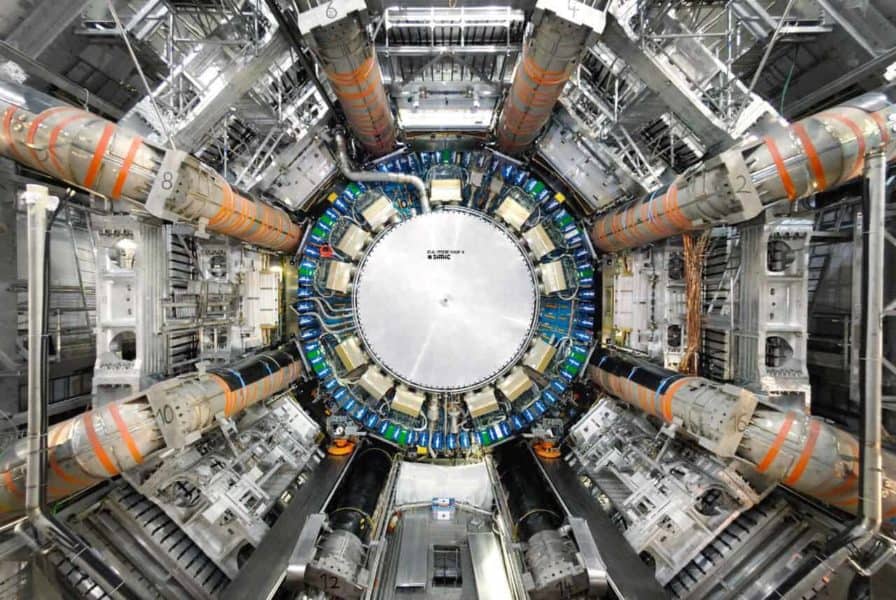In particle physics, it’s the anomalies, tensions, deviations, and discrepancies – the results that don’t quite sync with Standard Model-based predictions and calculations – that create a buzz among those working in the field.
The typical explanations are problems or limitations in measurements, algorithms, or analyses, but there is also the exciting possibility of new, not-yet-understood physics. And even if the outcome simply preserves the status quo, such confirmations can also be vital to free up the field to pursue other unresolved problems.
A new study, posted this week on the online preprint archive arXiv.org and will soon be submitted to a science journal, dives into a decades-old discrepancy within the Standard Model of particle physics, called “lepton flavor universality,” and provides strong evidence to resolve it.
Among the members of the lepton family are electrons and their heavier “siblings”: tau-leptons and muons. The Standard Model’s lepton flavor universality trait holds that the only difference between these three particle types, or “flavors,” is their mass, and that each lepton flavor is equally likely to interact with force-carrying particles such as the W boson.
A discrepancy in this trait first surfaced during the 1990s in experiments at CERN’s Large Electron Positron Collider (LEP), when interactions between the tau lepton and the W boson were found to be more likely than interactions between a W boson and an electron or muon.
Several recent analyses using data collected from the Belle, LHCb, and BaBar experiments have also hinted at discrepancies in this universality, though at lower energy scales.
The team of researchers leading the latest study – among them Josh McFayden, who joined the U.S. Department of Energy’s Lawrence Berkeley National Laboratory (Berkeley Lab) as a project scientist in April 2020 – used an entirely different approach to measure lepton flavor universality with higher precision.
The team tapped into data collected from 2015-2018 by the ATLAS detector at LEP’s successor, the Large Hadron Collider at CERN. The entire ATLAS collaboration, which has about 5,000 members from 180 countries, is credited in the study.
ATLAS researchers worked with a huge set of data for proton-proton particle collisions at the LHC that produced about 100 million pairs of particles known as top quarks and anti-top quarks. These pairs decayed into pairs of W bosons, and, in turn, the bosons decayed into tau-leptons, muons, and other elementary particles.
Subsequent decays of tau-leptons also led to the creation of other muons, and differentiating between the various sources of muons was key in providing a precise measurement of the ratio in the probability that the particle resulting from a W boson decay was a muon or a tau. The new measurement found nearly an equal probability, with a record precision in the uncertainty of about 1.3% – halving the uncertainty in earlier measurements.
The earlier LEP experiments had also analyzed decays from W bosons, but those were produced through the direct production of W boson pairs to yield a precision of about 2.6%. That measurement was not accurate enough to decisively conclude whether it revealed a departure from the Standard Model.
The presence of various sources of background noise in the data at first seemed very daunting, McFayden said.
“When people were looking at the sort of things you could measure at the LHC, they initially said this measurement wouldn’t be possible because of messier collisions and more complicated backgrounds at the LHC compared to those at LEP,” he said. “But we were able to exploit the very precise muon reconstruction algorithm developed by ATLAS to reach the required precision.”
The technique proved superior to a possible alternative approach studying “hadronic” tau decays – hadrons are another family of subatomic particles. McFayden said hadronic tau decays are much more complicated to reconstruct, leading to larger uncertainties.
To differentiate between the two types of muons that researchers wanted to measure – those that directly decayed from W bosons and those produced from subsequent decays of tau-leptons – the team analyzed how far each type traveled in the ATLAS detector, one of the giant detectors that gathers data on particle-collisions at the LHC.
Tau-leptons fly a couple of millimeters further in the detector than decays of the W bosons, allowing researchers to separate out muons produced from the tau-leptons. Improved filtering subsequently led to a higher overall precision in the final measurement.
“What we measured is very compatible with the Standard Model – it appears to be a fairly strong confirmation of the Standard Model,” McFayden said. Of course, new data from the LHC, expected during future runs, may lead to even higher-precision measurements.
McFayden noted that some peculiarities still exist in particle interactions involving tau-leptons, and the latest measurement could lead researchers to focus their efforts on resolving other tensions that appear in the LHC data.
“Something slightly weird is going on with the coupling of taus compared with other leptons,” McFayden said. “This makes it worthy of further attention.”
He noted the tau particle has particular historical significance to Berkeley Lab. A team of researchers from SLAC National Accelerator Laboratory and Berkeley Lab worked together to build the state-of-the-art detector that originally discovered the tau, earning SLAC scientist Martin Perl a Nobel Prize in physics in 1995.
McFayden said he and other colleagues in the ATLAS collaboration worked extensively on the latest study for about two years. A number of computer centers, including Berkeley Lab’s National Energy Research Scientific Computing Center (NERSC), contributed to the result. Researchers used NERSC to process numerous simulations of particle collisions, which aided in building a model to compare with the measured data.
McFayden’s contributions included developing the model used to help extract the ratio of the decay types that were the focus of the study, and narrowing the various uncertainties associated with simulations. Lowering these uncertainties contributed to the high-precision measurement achieved in this study.
NERSC is a DOE Office of Science user facility.
U.S. participation in ATLAS is supported by DOE’s Office of Science.


